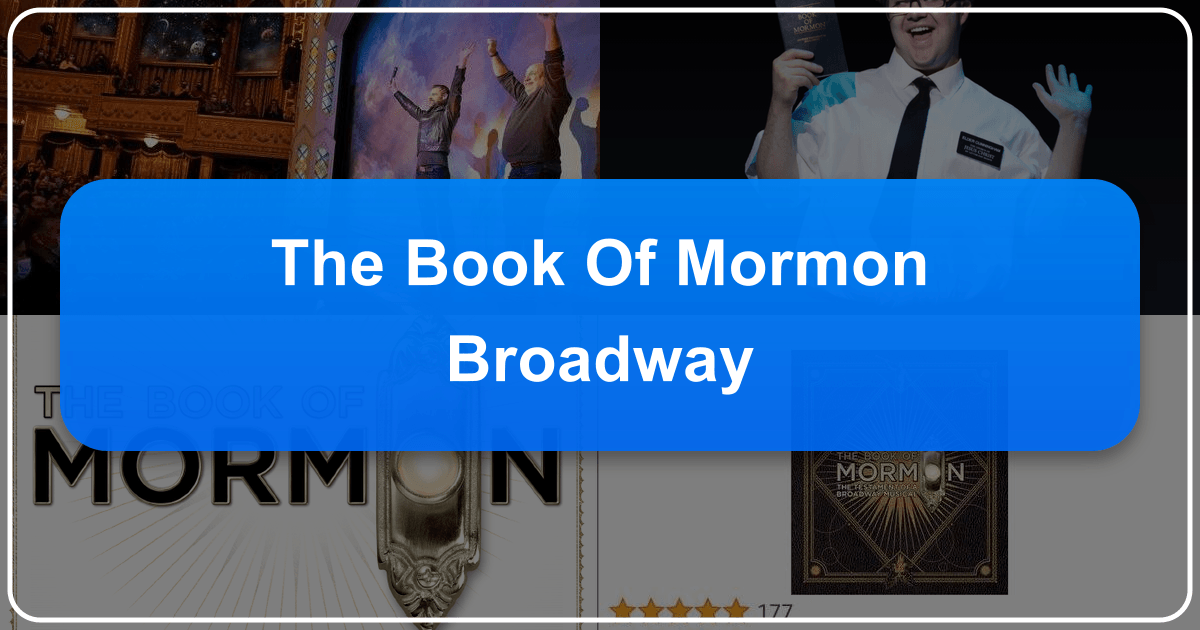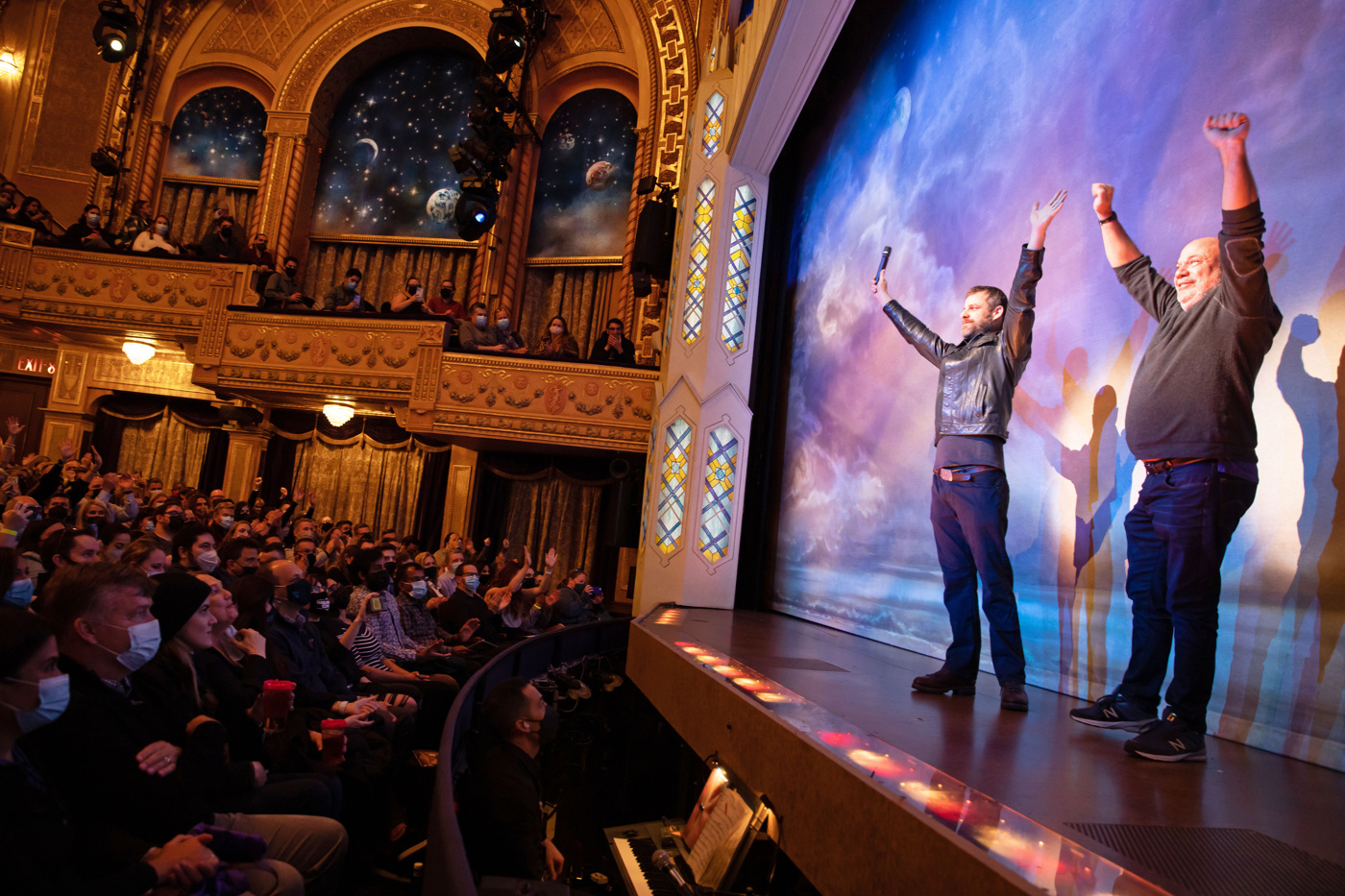The Book of Mormon: A Broadway Phenomenon

The Book of Mormon, a musical comedy with music, lyrics, and book by Trey Parker, Robert Lopez, and Matt Stone, has cemented its place as a Broadway juggernaut. Its irreverent humor, catchy tunes, and surprisingly poignant exploration of faith and doubt have captivated audiences worldwide, leading to numerous productions and accolades. This article delves into the multifaceted world of The Book of Mormon, examining its genesis, development, critical reception, cultural impact, and enduring legacy through the lens of several key themes.
The Genesis and Development of a Controversial Masterpiece
The Book of Mormon’s creation stemmed from a unique confluence of talents and a shared fascination with Mormonism. Trey Parker and Matt Stone, renowned for their animated series South Park, had long been intrigued by the Latter-Day Saint faith, a familiarity rooted in their Colorado upbringing. Their initial concept, conceived during the development of an aborted Fox series, centered around a fictionalized Joseph Smith, the founder of the Latter-Day Saint movement. This early idea eventually blossomed into a full-fledged musical.

Their collaboration with Robert Lopez, co-creator of the puppet musical Avenue Q, proved crucial. After witnessing a performance of Avenue Q, producer Scott Rudin suggested Parker and Stone see the show, recognizing a parallel between the marionettes of Team America: World Police (another Parker/Stone production) and the puppets in Avenue Q. This chance encounter led to a meeting, where Lopez’s mention of South Park: Bigger, Longer & Uncut’s influence on Avenue Q sparked a conversation about a shared desire to create a work involving Joseph Smith. This led to the quartet embarking on initial planning and research, including a trip to Salt Lake City to interview missionaries and ex-missionaries.
The project faced many challenges, however. Writer Jeff Marx, initially involved, eventually parted ways due to creative differences. The remaining trio—Parker, Stone, and Lopez—spent several years developing the musical, enduring multiple workshops, and investing considerable personal funds. These workshops were pivotal, allowing them to refine the story, the songs (some underwent significant alterations, such as “The Bible Is a Trilogy” becoming “All-American Prophet”), and even the character of the Ugandan warlord. These iterations, crucial in shaping the final product, included an early animatic to determine whether the show should even be a stage production or an animated film. Directorial changes also occurred during the development process, with Jason Moore initially directing the early workshops, and Casey Nicholaw ultimately co-directing with Parker and serving as choreographer.

The decision to bypass an Off-Broadway premiere and debut directly on Broadway was a bold move, driven by Rudin’s belief that Parker and Stone thrived under high-stakes situations. The production successfully adhered to a tight budget, going into previews shortly after a grueling rehearsal period.
The Book of Mormon: A Musical Comedy with a Sharp Satirical Edge
The Book of Mormon’s storyline follows two young Mormon missionaries, Elder Kevin Price and Elder Arnold Cunningham, as they embark on their missions to a remote Ugandan village. Their idealistic hopes quickly clash with the harsh realities of their assignment—a village grappling with poverty, famine, war, and the AIDS epidemic. The missionaries’ earnest attempts to convert the villagers are met with indifference and skepticism, forcing them to confront their own beliefs and faith.
The musical masterfully blends humor and satire, lampooning religious dogma, cultural stereotypes, and the naivete of well-intentioned but often clueless missionaries. The show’s success isn’t solely attributable to its shock value; it lies in its clever writing, memorable characters, and unexpectedly touching emotional core. The seemingly disparate elements of faith, doubt, and the human condition are interwoven with infectious musical numbers, ranging from upbeat and catchy to darkly humorous and self-reflective.

The musical numbers are integral to the narrative, driving the plot and revealing the characters’ evolving perspectives. Songs like “Hello!”, “Two by Two,” and “You and Me (But Mostly Me)” establish the missionaries’ contrasting personalities and motivations. The villagers’ chant, “Hasa Diga Eebowai,” provides a darkly comic counterpoint to the missionaries’ attempts at proselytizing. “Turn It Off” satirizes the suppression of doubt, while “Spooky Mormon Hell Dream” presents a surreal and hilarious exploration of Price’s internal conflicts. “Making Things Up Again” showcases Cunningham’s inventive adaptation of LDS teachings to connect with the villagers. Finally, the reprise of “You and Me (But Mostly Me)” underscores the profound transformation in the missionaries’ approach and the unexpected ways in which they find meaning and connection.
Musical Numbers and Instrumentation
The score is a remarkable blend of pop, musical theater, and even hints of other genres, reflecting the eclectic nature of the musical itself. The nine-member orchestra (with slight variations across productions) provides a dynamic soundscape that enhances the emotional range of the show.
The original Broadway cast recording, released by Ghostlight Records, captured the essence of the show’s music and lyrics, becoming one of the fastest-selling Broadway cast albums in iTunes history. Its success further contributed to the overall phenomenon of The Book of Mormon.
Critical Acclaim and Controversies: Navigating the Line Between Satire and Offense
The Book of Mormon’s reception has been as complex and layered as the musical itself. It garnered widespread critical acclaim, praising its witty script, infectious music, and powerful performances. The show’s bold satire, while occasionally crossing into controversial territory, ultimately resonated with audiences who appreciated its unconventional approach and its surprising heart. However, it also faced accusations of racism and insensitivity, particularly concerning its portrayal of Africans and their societal issues.
These criticisms prompted meaningful dialogues and ultimately led to script revisions in 2020, aimed at providing the Ugandan villagers with more agency and centering their experiences within the narrative. This response demonstrates the show’s ongoing evolution and its creators’ willingness to engage with critical perspectives to improve the production.
The response of The Church of Jesus Christ of Latter-day Saints to the musical was surprisingly measured, emphasizing the distinction between the fictionalized depiction in the musical and their faith’s actual teachings. This unexpected tolerance even led to the church taking out advertisements in playbills, encouraging audiences to read the actual Book of Mormon.
The Book of Mormon’s Enduring Legacy: A Cultural Impact
The Book of Mormon’s success transcends its theatrical achievements. Its blend of irreverent humor and genuine emotional resonance has earned it a significant place in popular culture. Its numerous productions worldwide, including long-running runs in London’s West End and national tours, solidify its status as a globally recognized musical. Its numerous awards, including nine Tony Awards (Best Musical, Best Book, Best Score, and several others) and a Grammy Award, further cement its critical and commercial success.
The show’s influence extends beyond Broadway. Its satire of religion and cultural attitudes has sparked dialogues and conversations, pushing boundaries and encouraging critical reflection. The controversy it generated, despite its comedic intent, underscores the power of art to engage with important social and cultural issues. The show’s ability to generate such intense discussion and reactions ultimately contributes to its enduring cultural relevance.
The Book of Mormon stands as a testament to the power of inventive storytelling, the brilliance of its creative team, and the enduring appeal of musical theater that can both entertain and provoke. Its place in the annals of Broadway history is secure, not only for its box office success, but also for its capacity to initiate important conversations while offering a hilarious and thought-provoking theatrical experience.